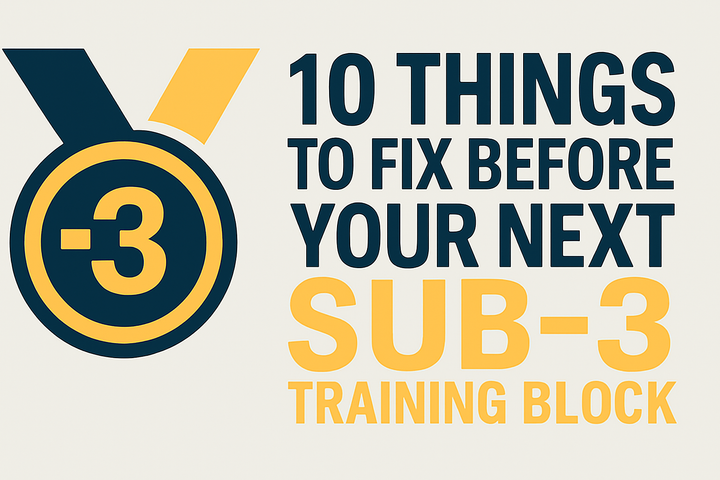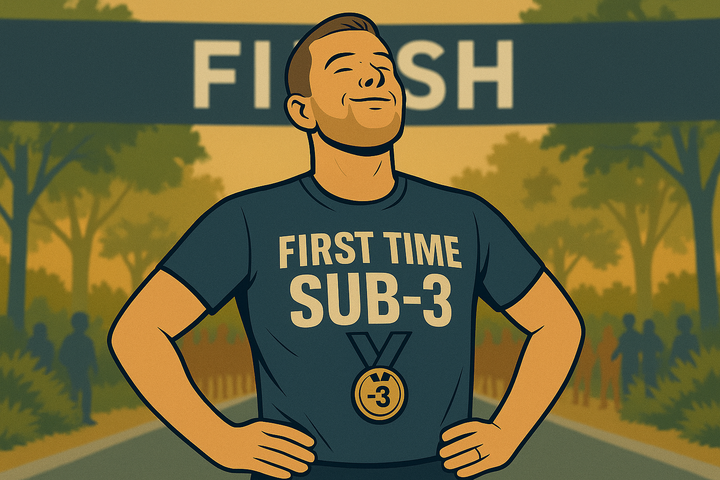10 things you must do to run a sub-3 marathon
Breaking three hours isn’t easy, but it’s possible. These are the ten habits, strategies and mindsets that set successful sub-3 runners apart.

Are you training hard but still wondering what it really takes to break three hours for the marathon? You’re not alone. Sub-3 is one of the most respected benchmarks in amateur distance running, and for good reason. It’s not easy, but for most of us, it is possible. Here are 10 things that really matter if you’re serious about chasing it - drawn from the habits and patterns that show up time and again in those who make it.
1. Run high mileage, consistently
You won’t find many sub-3 marathoners getting by on minimalist plans. Building a strong aerobic base takes time and volume. Think 100km or more each week as standard, with peak weeks in the block pushing well beyond that. If you want to race for three hours, you simply cannot underestimate the importance of “time on legs”. This may sound daunting, but bear in mind that much of this can be done very slowly - a classic mistake is to try to cover the ground too quickly.
2. Train hard, not just long
Sub-3 doesn’t just require time on feet - it requires sharpness and grit. That means interval sessions that push you to the edge, hill repeats where you give everything then jog down and go again, and sustained tempo efforts that build race-day control. You also need to train when you don’t feel like it - in the cold, the dark, the rain. Don’t wait for perfect conditions. Make the time, and get it done.
3. Master the long run
The long run isn’t just about logging distance. It’s a weekly opportunity to build endurance, practise fuelling, rehearse race-day pacing and test your ability to hold form under fatigue. Sub-3 runners don’t just survive their long runs - they shape them carefully and use them to prepare for what’s coming.
4. Eat like it matters
Fuel isn’t just about race-day gels or pre-run porridge. Sub-3 runners pay attention to how they eat across the week - getting enough protein, keeping weight stable, and building meals that support training, recovery and body composition. It's not about restriction or fads. It’s about fuelling the work properly. and ensuring your body has what it needs to recover.
5. Lose excess weight - and keep it off
Running lighter is running easier. That doesn’t mean chasing unrealistic body image goals, but if you’re carrying excess fat, dropping it will improve your efficiency, lower your injury risk and make a sub-3 effort feel more manageable. Weight loss isn’t a magic fix, but it’s often the biggest single gain available for those seeking sub-3.
6. Use the right tools - but don’t rely on them
Carbon shoes, smart scales, beetroot juice and GPS watches all have their place, and many sub-3 runners make use of them. But gear only gets you so far. The tools can help, especially in the margins, but they’re not a substitute for proper training, high mileage and nailing body composition.
7. Race before you race
Sub-3 runners don’t wait until marathon day to test themselves. Tune-up races, parkruns and hard threshold sessions under pressure help build sharpness, expose weaknesses and reduce uncertainty. Parkrun, in particular, can be a valuable sandbox — a place to practise tactics and push effort levels without the weight of an A race.
8. Get comfortable being uncomfortable
Sub-3 isn’t just a test of fitness - it’s a test of control under pressure. You need to stay calm when the pace feels harder than expected, push through patches of doubt without panicking, and keep your form when your legs are starting to fade. The only way to build that resilience is by practising it in training - whether that means finishing strong on tired legs, running fasted when you’d rather not, or embracing solo efforts that test your mindset as much as your fitness.
9. Stay connected - but filter the noise
Strava, WhatsApp groups and Facebook forums can be useful for picking up ideas, sharing experiences and feeling part of something bigger. But they can also create noise, distraction and unhelpful comparison. Use them for support and tips, but sparingly.
10. Respect the commitment
You don’t have to turn your life upside down to go sub-3, but it won’t happen by accident. Training needs to be consistent, recovery needs to be taken seriously, and you’ll likely need to say no to a few things along the way. Careful logistical planning may be needed - and there may a bit less Netflix, and some earlier nights and earlier starts than desirable. But, in general, where there’s a will, there’s a way.
Sub-3 isn’t for everyone — not every body type or stage of life makes it a realistic target. But for many runners, it’s more achievable than they think. If you’re willing to train hard, train smart and treat the goal with the respect it deserves, then it’s within reach.
Enjoyed this article? Help keep Sub-3 running — support us with a coffee.
To help fund the running of the site, Sub-3 is an Amazon Associate and earns from qualifying purchases. We only recommend gear or kit that has genuinely helped in our own running and that we believe is worth considering.



